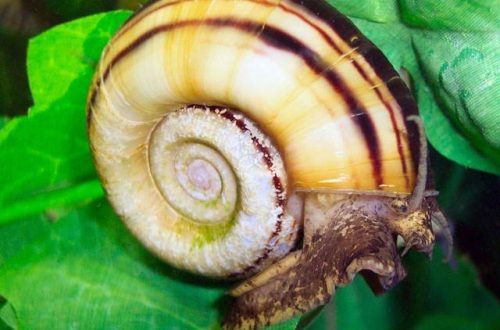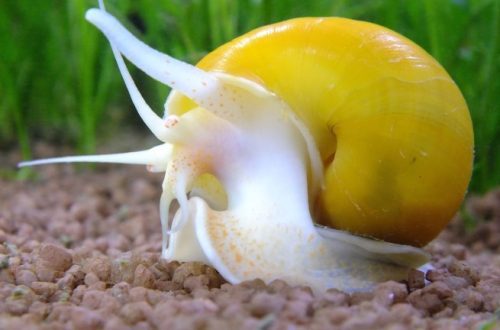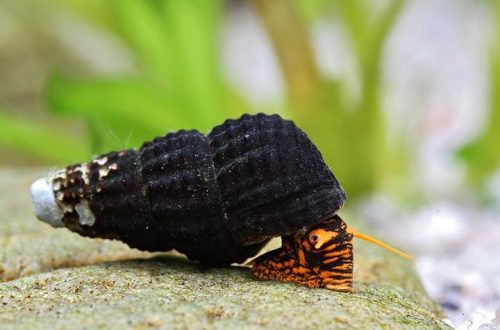
Theodoxus snail: content, reproduction, description, photo

Contents
The main features of the species
The genus belongs to the Neretid family. Like most relatives, they can live in both fresh and brackish water. Their size reaches an average of a centimeter in height. The shell is rounded, with a slight curl; to many, it resembles a bowl or cup in shape. On the back surface of the sole there is a cap, with which the animal closes the entrance as needed, like ampoules. The sole is light, the lid and entrance are yellowish.
The color of mollusks is very diverse and beautiful. The pattern of the shells is contrasting – large and small specks or intermittent zigzags on a lighter or darker background. The shells themselves are thick-walled and dense, very durable. The fact is that in nature, mollusks live in reservoirs with a rather strong current, and a strong shell is simply necessary for them in these conditions.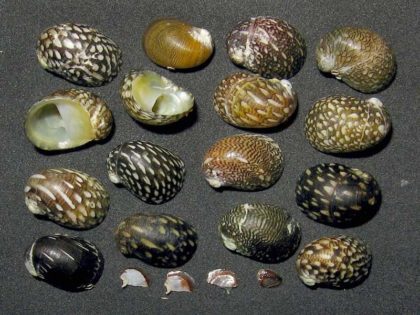
Varieties:
- Theodoxus danubialis (theodoxus danubialis) – very beautiful mollusks with shells of lime-white color with a whimsical pattern of dark zigzags of different thicknesses. They can grow up to one and a half centimeters. They love hard water.
- Theodoxus fluviatilis (theodoxus fluviatilis) – the species is distributed over a large area, but at the same time it is considered rare. Distributed in Europe, Russia, Scandinavian countries. The shells are dark in color – brown, bluish, purple, with clear white speckles. They have an interesting habit: before eating algae, they grind them on stones. Therefore, the soil is preferred rocky.
- Theodoxus transversalis (theodoxus transversalis) – rather small snails, shells without a pattern, colors from grayish to yellowish or brown-yellow.
- Theodoxus euxinus (theodoxus euxinus) – molluscs with a shell of a very pleasant light color, with an elegant pattern of thin broken lines and specks. They live in warm regions – Romania, Greece, Ukraine.
- Theodoxus pallasi (theodoxus pallasi) – live in brackish and salty water. Natural area – Azov, Aral, Black Sea, rivers belonging to their basins. Less than a centimeter in size, the colors are dark specks and zigzags on a grayish-yellow background.
- Theodoxus astrachanicus (theodoxus astrachanicus) – live in the Dniester, the rivers of the Azov Sea basin. These gastropods have a very beautiful and clear shell pattern: frequent dark zigzags on a yellowish background.
Who are theodoxus
These are very small freshwater snails that live in the waters of Russia, Ukraine, Belarus, Poland, Hungary. They are also found in the Baltic and Scandinavian countries.
In fact, they can only be partially called freshwater, since some species of the Theodoxus genus live in the Azov, Black and Baltic Seas. In principle, hundreds of thousands of years ago, all these gastropods lived in salty sea water, and then some species gradually moved to fresh rivers and lakes.
Nothing exotic at first glance. However, one should not be disappointed ahead of time, these domestic representatives of the class of gastropods have a variety of shell colors, interesting habits, and characteristic features of reproduction. Finally, they are simply beautiful!
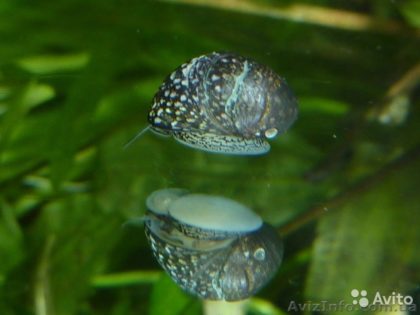
As a rule, these neretids live on hard rocks, which is associated with the nature of their diet. They scrape off the smallest algae and detritus (the remains of decomposed organic matter) from hard surfaces covered with water.
Snails do best in hard water. And this is not surprising, since they need a lot of calcium to build a shell.
Many people have probably met these mollusks in their native rivers and lakes, but few people think that they can be successfully kept in their small aquarium for the good of the cause. The average lifespan of neretids is about 3 years.
Content
The maintenance of these wonderful snails is not at all difficult. They feel equally comfortable both at a temperature of +19 and at +29. They feed on algae, and work actively – these are excellent helpers, thanks to which it is much easier for the owner to keep the aquarium clean. True, hard algae fouling, such as “black beard”, is too tough for them. Snails leave higher plants intact – this is also their big plus. As a rule, the aquarium in which these gastropods live always looks neat, and the vegetation in it is clean and healthy.
Many species of mollusks prefer fairly hard water, rich in calcium – they need it for a strong shell. You can put sea (limestone) stones in them in the aquarium (taking into account, of course, the interests of other inhabitants of the aquarium). They also dislike stagnant water.
Snails contain no less than 6-8 at once. They are still very small, so in smaller numbers you simply will not notice them in the aquarium. In addition, such an amount is necessary for reproduction. The fact is that these mollusks are both heterosexual and bisexual, and at the same time males do not differ from females at all.
An interesting feature of the behavior of these cute inhabitants of the aquarium is that each of them has its own place in the “family”. This is the point where the pet rests and the area of uXNUMXbuXNUMXbthe territory that it “processes”. As a rule, this is a hard surface – they prefer it to the leaves and stems of plants. It often happens that a small theodoxus settles on the shell of larger mollusks. Snails carefully and methodically clear their areas of fouling, and only an acute shortage of food can force them to leave the boundaries of this place.
Reproduction: frequency and features
As already mentioned, in conditions of a constant temperature of the aquarium aquatic environment, snails can give birth throughout the year, regardless of the season. The optimum water temperature for breeding is +24°C.
Theodoxus females lay their eggs on a hard surface – stones, vessel walls. The smallest eggs are enclosed in an oblong capsule no more than 2 mm long. Despite the fact that one such capsule contains several eggs, after 6-8 weeks only one baby snail hatches. The rest of the eggs serve as food for him.
Babies grow very slowly. Immediately after birth, they constantly hide in the ground, the shell of their whitish shell is very fragile. Juveniles also grow slowly.
The frequency of reproduction of one female is 2-3 months. Given the slow growth of snails, their short life expectancy, you can not be afraid of overpopulation of your aquarium and any disturbances in the balance of the biosystem.
Ease of reproduction, unpretentiousness, ease of maintenance – this is what distinguishes the gastropods of theodoxus. In addition, they are excellent and conscientious aquarium cleaners. It seems that these small mollusks deserve closer attention from domestic lovers of aquatic fauna.
Habitat
Habitat. Theodoxus are native to the Dniester, Dnieper, Don and Southern Bug rivers, and can often be found in the tributaries of these rivers and lakes. The habitats of these snails are tree roots submerged in water, plant stems and coastal stones. Theodoxus tolerate heat well, so they can often be seen on land.
Appearance and coloring.
Theodoxus belong to the neritidae family and measure about 6,5 mm x 9 mm. The body and operculum are light yellow in color, the sole or leg is white. The shell walls are thick, adapted to the rapid currents of rivers in the natural environment. The shells themselves can be of different colors with a variety of patterns (white, black, yellow with dark zigzag lines, reddish brown with white spots or stripes).
Theodoxus have gills and an operculum – this is a lid that closes the shell like an ampullar. On the back of the leg there are special caps that close the mouth of the shell.
Sexual signs
Theodoxus, depending on the species, can be both same-sex and heterosexual. The sex cannot be visually distinguished.



